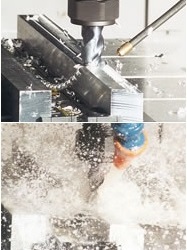Minimum Quantity Lubrication v Flood
 We have known UNIST for many years as leaders in MQL technology with bold confidence in their systems and products. The October 2016 edition of TLT Magazine, the STLE monthly publication, includes the article "20 Minutes With Tim Walker." Mr. Walker is the Senior VP of UNIST. He details the advantages and application criteria for use of MQL. As shown in the lower of the two pictures from UNIST's website,"flood coolant relies on conductive heat transfer" (looks like convection to us) to remove heat, MQL relies on the lubricant reducing the heat created in the secondary shear zone. In the upper picture, you can hardly see the flow at all. MQL pros are environmental, enterprise and economic. No fluid to dispose of, no dermatitis, cleaner parts, and cost savings. On the downside, its a more sensitive process that requires intelligent application in terms of output location, quantity, and chemistry of the coolant. Simple machines, like saws, are easier to fit. Fitting to a CNC machine is a skilled process. Right now, Ford, Volvo, Mercedes-Benz, BMW and VW all use MQL extensively on many parts including crankshafts and gearboxes. STLE is a not for profit organization that publishes TLT monthly.
We have known UNIST for many years as leaders in MQL technology with bold confidence in their systems and products. The October 2016 edition of TLT Magazine, the STLE monthly publication, includes the article "20 Minutes With Tim Walker." Mr. Walker is the Senior VP of UNIST. He details the advantages and application criteria for use of MQL. As shown in the lower of the two pictures from UNIST's website,"flood coolant relies on conductive heat transfer" (looks like convection to us) to remove heat, MQL relies on the lubricant reducing the heat created in the secondary shear zone. In the upper picture, you can hardly see the flow at all. MQL pros are environmental, enterprise and economic. No fluid to dispose of, no dermatitis, cleaner parts, and cost savings. On the downside, its a more sensitive process that requires intelligent application in terms of output location, quantity, and chemistry of the coolant. Simple machines, like saws, are easier to fit. Fitting to a CNC machine is a skilled process. Right now, Ford, Volvo, Mercedes-Benz, BMW and VW all use MQL extensively on many parts including crankshafts and gearboxes. STLE is a not for profit organization that publishes TLT monthly.


